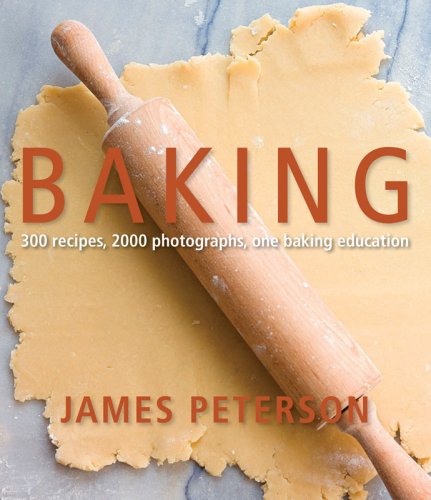About this item
The learn-to-bake master class in a book.The craft of baking is based on good technique. Learn the fundamentals well, and you can bake perfect cakes, cookies, tarts, breads, and pastries each and every time.That's the premise of Baking, revered cooking teacher James Peterson's master course in baking fundamentals. In more than 350 recipes and auxiliary techniques--most accompanied by illuminating step-by-step photographs--Peterson lays the foundation for lifelong baking success.This book teaches you how to build finished baked goods from their essential components, providing both maximum guidance for less experienced bakers and great creative freedom for more confident bakers. The Cakes chapter, for example, presents basic cake recipes (Moist Sponge Cake, Devil' s Food Cake) followed by frostings, fillings, and glazes (Professional-Style Buttercream, White Chocolate Ganache) , allowing you to mix and match endlessly. Or, if you're looking for knockout assembled cakes, go to the end of the chapter and discover complete illustrated instructions for, say, a decadent Chocolate Hazelnut Cake with Chocolate Filling and Hazelnut Buttercream, or an elegant Peach Crme Mousseline Cake. Baking is packed with the basic, must-have recipes for every baker's repertoire (as well as more ambitious classics) , such as:Pound Cake * Crme Anglaise * Chiffon Cake * Cheesecake * Classic Puff Pastry * Cherry Pie * Lemon Meringue Pie * Miniature Raw Fruit Tarts * Linzertorte * Cream Puffs * Chocolate Croissants * Cheese Danish * Basic Butter Cookies * Lemon Bars * Biscotti * Challah * Rye Bread * Focaccia * Blueberry Muffins * Scones * Flourless Chocolate Cake * Cheese Souffles * Miniature Cake Petits Fours * Apple Strudel * Napoleons * Rolled Fondant * Bche de Nol * clairs * Mushroom JalousieCopious photographs inspire and help bakers visualize the crucial moments of hundreds of recipes and techniques, including:Troubleshooting Tarts and Pies * Baking "Blind" * Making Liquid Fondant * Coating a Cake with Hot Icing * Assembling a Layer Cake without Using a Cake Stand * Decorating a Cake with a Caramel Cage * Coloring Marzipan * Making a Rolled Cake * Decorating Cookies with Colored Sugar * Filling and Using a Pastry Bag * Kneading Wet Dough in a Food Processor * Scoring Dough * Shaping a Fougasse * Repairing Chocolate Mixtures that Have Seized * Cooking Sugar Syrup to the Soft Ball StageThorough, approachable, and authoritative, Baking shows why James Peterson is a trusted source for home cooks of every level. Work your way through this book, and you will gain the skills you'll need for impressive results every time.
About the Author
James Peterson
James Peterson grew up in northern California and studied chemistry and philosophy at UC Berkeley. After his studies, he traveled around the world, working his way through Asia, by land, to Europe. Eventually he landed in Paris and was amazed by the French attitude toward food and drink. (This was in the mid seventies when food in America was practically non-existent. ) It was in France that he found his calling. As he was running short on funds, Jim found a job picking grapes in the south of France where he lived with a family for two weeks. He has never forgotten the sumptuous lunches prepared by the vigneron's wife. After his initial inspiration, Jim returned to the United States and got a job as a short-order cook. This was his first cooking job and while the cuisine was not 3-star, there was still the need for speed and organization. After saving money for a year and a half, Jim returned to France. After begging his way in, he ended up working at two of what were then among France's greatest restaurants, George Blanc and Vivarois. It was his experiences in these restaurants that shaped his style of cooking and drove his pursuit of cuisine as a career. Jim also studied pastry at Le Cordon Bleu in Paris. By a series of serendipitous events, James found himself a partner/chef in a small French restaurant in Greenwich Village, called Le Petit Robert. It was here that he was able to experiment and invent and shape his own unique approach to cooking. The restaurant was reviewed in a wide variety of major publications including Gourmet Magazine where it was called "...what may be the most creative restaurant in New York. " It was no doubt in part because of his extravagant use of truffles and foie gras, that the restaurant, after four years, was forced to close. At a loss, Jim started teaching cooking at the French Culinary Institute and later, at Peter Kump's New York Cooking School, now ICE. Jim spent a year developing curriculum for the French Culinary Institute.After translating a series of French pastry books, Jim established a relationship with a publisher who encouraged him to write his own book. His first book, Sauces, published in 1991, continues to sell as well now as it did the first year after publication. It won the James Beard Cookbook of the Year Award and put James on the map as a serious writer and teacher. Other books followed: Splendid Soups, nominated for both a James Beard and IACP Award, Fish & Shellfish, nominated for both awards and a winner of an IACP Award, Vegetables, winner of a James Beard Award, The Essentials of Cooking, nominated for both awards.It was during the writing and preparation of Fish & Shellfish that Jim starting taking his own pictures for his books. This started what has become a twenty-year obsession with photography. He set out to write and photograph a definitive technique book similar to Jacques Pepin's La Technique except in full color and updated. After the p
Report incorrect product information.


